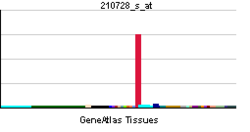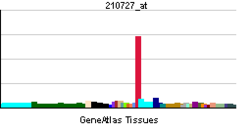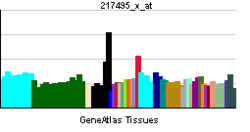Calcitonin
Calcitonin/calcitonin-related polypeptide, alpha
| ||||||||||||||
| Identifiers | ||||||||||||||
| Symbol(s) | CALCA; CALC1; CGRP; CGRP-I; CGRP1; CT; KC; MGC126648 | |||||||||||||
| External IDs | OMIM: 114130 MGI: 2151253 HomoloGene: 1319 | |||||||||||||
| ||||||||||||||
| RNA expression pattern | ||||||||||||||
| Orthologs | ||||||||||||||
| Human | Mouse | |||||||||||||
| Entrez | 796 | 12310 | ||||||||||||
| Ensembl | ENSG00000110680 | ENSMUSG00000030669 | ||||||||||||
| Uniprot | P01258 | Q99JA0 | ||||||||||||
| Refseq | NM_001033952 (mRNA) NP_001029124 (protein) |
NM_001033954 (mRNA) NP_001029126 (protein) | ||||||||||||
| Location | Chr 11: 14.94 - 14.95 Mb | Chr 7: 114.42 - 114.43 Mb | ||||||||||||
| Pubmed search | [1] | [2] | ||||||||||||
Calcitonin is a 32 amino acid polypeptide hormone that is involved in calcium regulation in vertebrates. It acts to reduce blood calcium (Ca2+) levels, working in opposite but complementary ways to the effects of the 84 amino acid parathyroid hormone (PTH), which acts to increase the concentration of calcium in the blood. Calcitonin also acts to regulate phosphorus metabolism.
Calcitonin has been found in a diversity of fish, reptiles, birds, and mammals, including humans. In humans, calcitonin is produced by the cells of the thyroid, while in many submammalian species it is produced by a distinct ultimobranchial body, a small organ found in the neck region (Ogle and Costoff 1999). The amino acid sequence shows differences between various groups, with salmon calcitonin, for example, differing in three amino acids from eel calcitonin (Noda and Narita 1976) and by 16 amino acids from that of humans (Ogle and Costoff 1999). Interestingly, calcitonin from salmon ultimobranchial bodies exhibits greater biological activity and longer half-life in humans than even human calcitonin, such as in arresting bone resorption, and it is often used in clinical medicine for treating various ailments, such as metabolic bone disease (Ogle and Costoff 1999).
The opposite and yet complementary effects of calcitonin relative to parathyroid hormone is reflective of the philosophy of Yin and Yang. Just as Yin and Yang are opposing, yet complementary and interdependent forces, calcitonin and parathyroid hormone complement each other and are both necessary to create overall harmony and balance in the living organism.
Chemistry, species differences, and formation
Calcitonin is a small peptide of 32 amino acids and a molecular weight of 3500, with a characteristic disulfide bridge between amino acids one and seven (Ogle and Costoff 1999).
Species differences in amino acid sequences are small. For example, eel calcitonin has the following sequence (Noda and Narita 1976):
- Cys-Ser-Asn-Leu-Ser-Thr-Cys-Val-Leu-Gly-Lys-Leu-Ser-Gln-Glu-Leu-His-Lys-Leu-Gln-Thr-Tyr-Pro-Arg-Thr-Asp-Val-Gly-Ala-Gly-Thr-Pro.
This differs only in the 26th, 27th, and 29th positions in comparison with salmon calcitonin I:
- Cys-Ser-Asn-Leu-Ser-Thr-Cys-Val-Leu-Gly-Lys-Leu-Ser-Gln-Glu-Leu-His-Lys-Leu-Gln-Thr-Tyr-Pro-Arg-Thr-Asn-Thr-Gly-Ser-Gly-Thr-Pro
Human calcitonin differs in 16 positions from salmon calcitonin:
- Cys-Gly-Asn-Leu-Ser-Thr-Cys-Met-Leu-Gly-Thr-Tyr-Thr-Gln-Asp-Phe-Asn-Lys-Phe-His-Thr-Phe-Pro-Gln-Thr-Ala-Ile-Gly-Val-Gly-Ala-Pro
In humans, calcitonin is produced by the parafollicular cells (also known as C-cells) that surround the thyroid follicular cells in the thyroid. The ultimobranchial body is the source of calcitonin in many other non-mammalinan species. In humans, the ultimobranchial body is an embryological structure that gives rise to the calcitonin-producing cells, or parafollicular cells (also called clear cells) of the thyroid gland.
Calcitonin is formed by the proteolytic cleavage of a larger prepropeptide, which is the product of the CALC1 gene (CALCA ). The CALC1 gene belongs to a superfamily of related protein hormone precursors including islet amyloid precursor protein, calcitonin gene-related peptide, and the precursor of adrenomedullin. CT is cleaved from a prohormone that also contains two other peptides, katacalcin and calcitonin gene-related peptide (CGRP). These peptides are secreted 1:1 with CT and are therefore found in equimolar ratio with CT in the circulation. Some evidence suggests that CGRP is a vasodilator. CT and CGRP have been isolated from other organs, including the pituitary, suggesting that they may have other functions besides lowering plasma calcium.
Physiology and actions
Calcitonin participates in calcium (Ca2+) and phosphorus metabolism. It causes a short-lived and rapid drop in blood calcium and phosphorous levels by advancing the incorporation of these ions into the bones (SMART 2008).
To be specific, calcitonin reduces blood Ca2+ levels in three ways:
- Decreasing Ca2+ absorption by the intestines (Ogle and Costoff 1999b);
- Decreasing osteoclast activity in bones (Ogle and Costoff 1999c);
- Decreasing Ca2+ and phosphate reabsorption by the kidney tubules (Ogle and Costoff 1999d).
Its actions, in a broad sense, are:
- Bone mineral metabolism:
- - Prevent postprandial hypercalcemia resulting from absorption of Ca2+ from foods during a meal
- - Promote mineralization of skeletal bone
- - Protect against Ca2+ loss from skeleton during periods of Ca2+ stress such as pregnancy and lactation
- Vitamin D regulation
- A satiety hormone:
- - Inhibit food intake in rats and monkeys
- - May have CNS action involving the regulation of feeding and appetite
The calcitonin receptor, found primarily on osteoclasts, is a G protein-coupled receptor, which is coupled by Gs to adenylyl cyclase and thereby to the generation of cAMP in target cells.
Salmon calcitonin has the highest hormonal activity among currently isolated calcitonins (Noda and Narita 1976), with considerably greater effectiveness in arresting bone resorption than human forms.
In many ways, calcitonin has the counter effects of parathyroid hormone (PTH). Parathyroid hormone is secreted by the parathyroid glands as a polypeptide containing 84 amino acids. It acts to increase the concentration of calcium (Ca2+) in the blood. It does this by acting upon parathyroid hormone receptor in different parts of the body.
Calcitonin was purified in 1962 by Copp and Cheney, who originally identified it as a secretion of the parathyroid glands (Cope and Cheney 1962).
Medical uses
As a hormone involved in regulating calcium metabolism, calcitonin has a number of medical applications. Synthetic human products (such as Calcimar and Miacalcin) are sold for this purpose. Most calcitonin used for patients is derived from salmon (Wood and Odle 2006), given the greater hormonal activity of salmon calcitonin. At present, it is commercially produced either by recombinant DNA technology or by chemical peptide synthesis; the pharmacological properties of the synthetic and recombinant peptides have been demonstrated to be qualitatively and quantitatively equivalent (APBI 208).
Calcitonin helps to slow the rate of bone destruction, reducing breakage of bone and causing less bone tissue to be reabsorbed (Wood and Odle 2006). Among medical uses of calcitonin are for post-menopausal osteoporosis, cancer patients experiencing bone pain caused by metastais, treatment of Paget's disease, and cases of increased levels of calcium in the blood (hypercalcaemia) (Wood and Odle 2006). It also is used for phantom limb pain (Wall and Heyneman 1999).
Salmon calcitonin is rapidly absorbed and eliminated, with peak plasma concentrations attained within the first hour of administration. Calcitonin has short absorption and elimination half-lives of 10-15 minutes and 50-80 minutes, respectively. Salmon calcitonin is primarily and almost exclusively degraded in the kidneys, forming pharmacologically-inactive fragments of the molecule. Therefore, the metabolic clearance is much lower in patients with end-stage renal failure than in healthy subjects (APBI 2008).
Oral calcitonin may have a chondroprotective role in osteoarthritis (OA), according to data from experimentation with rats presented in December, 2005, at the 10th World Congress of the Osteoarthritis Research Society International (OARSI). Although calcitonin is an established antiresorptive agent, its disease-modifying effects on chondrocytes and cartilage metabolisms have not been well established until now. This new study, however, may help to explain how calcitonin affects osteoarthritis. According to one of the researchers, "Calcitonin acts both directly on osteoclasts, resulting in inhibition of bone resorption and following attenuation of subchondral bone turnover, and directly on chondrocytes, attenuating cartilage degradation and stimulating cartilage formation." (Kleinman 2006).
ReferencesISBN links support NWE through referral fees
- Association of the British Pharmaceutical Industry (ABPI). 2008. Medicines Compendium Datapharm Communications. Retrieved May 27, 2008.
- Boron, W. F., and E. L. Boulpaep. 2005. Medical Physiology: A Cellular and Molecular Approach. Philadelphia, Pa: Elsevier Saunders. ISBN 1416023283.
- Copp, D. H., and B. Cheney. 1962. Calcitonin-a hormone from the parathyroid, which lowers the calcium-level of the blood. Nature 193:381-2. PMID 13881213.
- Kleinman, D. M. 2006. Oral calcitonin may delay onset of joint disease and relieve pain of OA Musculoskelital Report January 4, 2006. Retrieved May 27, 2008.
- Noda, T., and K. Narita. 1976. Amino acid sequence of eel calcitonin J. Biochem 79(2): 353-359.
- Ogle, T. E., and A. Costoff. 1999a. Endocrinology: Anatomy, structure, and synthesis of calcitonin (CT) Section 5, Chapter 6 in T. M. Novak, Essentials of Human Physiology. Gold Standard Multimedia and Medical College of Georgia. Retrieved May 27, 2008.
- ———. 1999b. Sect. Endocrinology: Effects of CT on the Small Intestine Section 5, Chapter 6 in T. M. Novak, Essentials of Human Physiology. Gold Standard Multimedia and Medical College of Georgia. Retrieved May 27, 2008.
- ———. 1999c. Endocrinology: Effects of CT on bone Section 5, Chapter 6 in T. M. Novak, Essentials of Human Physiology. Gold Standard Multimedia and Medical College of Georgia. Retrieved May 27, 2008.
- ———. 1999d. Endocrinology: Effects of CT on kidneys Section 5, Chapter 6 in T. M. Novak, Essentials of Human Physiology. Gold Standard Multimedia and Medical College of Georgia. Retrieved May 27, 2008.
- Simple Modular Architecture Research Tool (SMART). 2008. Calcitonin SMART. Retrieved May 27, 2008.
- Wall, G. C., and C. A. Heyneman. 1999. Calcitonin in phantom limb pain Ann Pharmacother. 33(4):499-501. Retrieved May 27, 2008.
- Wood, D., and T. G. Odle. 2006. In J. L. Longe, The Gale Encyclopedia of Cancer. Detroit, MI: Gale. ISBN 1414403623.
Further reading
- Di Angelantonio, S., R. Giniatullin, V. Costa, et al. 2004. Modulation of neuronal nicotinic receptor function by the neuropeptides CGRP and substance P on autonomic nerve cells Br. J. Pharmacol. 139(6): 1061-73. PMID 12871824. Retrieved May 27, 2008.
- Findlay, D. M., and P. M. Sexton. 2005. Calcitonin Growth Factors 22(4): 217-24. PMID 15621724. Retrieved May 27, 2008.
- MacIntyre, I., M. Alevizaki, P. J. Bevis, and M. Zaidi. 1987. Calcitonin and the peptides from the calcitonin gene Clin. Orthop. Relat. Res. 217: 45-55. PMID 3549095. Retrieved May 27, 2008.
- Schneider, H. G., and Q. T. Lam. 2007. Procalcitonin for the clinical laboratory: A review Pathology 39(4): 383-90. PMID 17676478.
- Sponholz, C., Y. Sakr, K. Reinhart, and F. Brunkhorst. 2007. Diagnostic value and prognostic implications of serum procalcitonin after cardiac surgery: A systematic review of the literature Critical Care 10(5): R145. PMID 17038199.
| Hormones and endocrine glands - edit |
|---|
|
Hypothalamus: GnRH - TRH - CRH - GHRH - somatostatin - dopamine | Posterior pituitary: vasopressin - oxytocin | Anterior pituitary: GH - ACTH - TSH - LH - FSH - prolactin - MSH - endorphins - lipotropin Thyroid: T3 and T4 - calcitonin | Parathyroid: PTH | Adrenal medulla: epinephrine - norepinephrine | Adrenal cortex: aldosterone - cortisol - DHEA | Pancreas: glucagon- insulin - somatostatin | Ovary: estradiol - progesterone - inhibin - activin | Testis: testosterone - AMH - inhibin | Pineal gland: melatonin | Kidney: renin - EPO - calcitriol - prostaglandin | Heart atrium: ANP Stomach: gastrin | Duodenum: CCK - GIP - secretin - motilin - VIP | Ileum: enteroglucagon | Liver: IGF-1 Placenta: hCG - HPL - estrogen - progesterone Adipose tissue: leptin, adiponectin Target-derived NGF, BDNF, NT-3 |
| ||||||||||||||
Credits
New World Encyclopedia writers and editors rewrote and completed the Wikipedia article in accordance with New World Encyclopedia standards. This article abides by terms of the Creative Commons CC-by-sa 3.0 License (CC-by-sa), which may be used and disseminated with proper attribution. Credit is due under the terms of this license that can reference both the New World Encyclopedia contributors and the selfless volunteer contributors of the Wikimedia Foundation. To cite this article click here for a list of acceptable citing formats.The history of earlier contributions by wikipedians is accessible to researchers here:
The history of this article since it was imported to New World Encyclopedia:
Note: Some restrictions may apply to use of individual images which are separately licensed.


